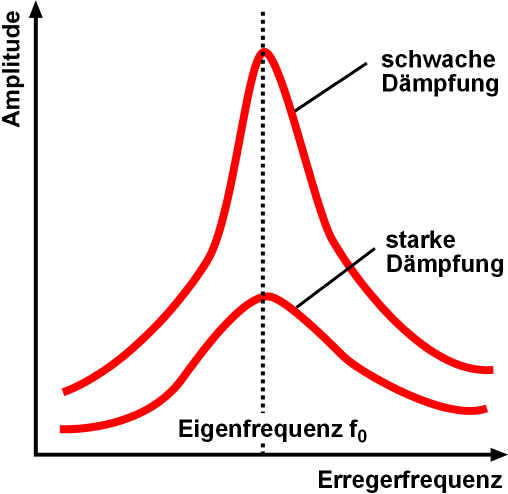|
Mechanical Resonance
Mechanical resonance is the tendency of a mechanical system to respond at greater amplitude when the frequency of its oscillations matches the system's natural frequency of vibration (its '' resonance frequency'' or ''resonant frequency'') closer than it does other frequencies. It may cause violent swaying motions and potentially catastrophic failure in improperly constructed structures including bridges, buildings and airplanes. This is a phenomenon known as resonance disaster. Avoiding resonance disasters is a major concern in every building, tower and bridge construction project. The Taipei 101 building relies on a 660-ton pendulum—a tuned mass damper—to modify the response at resonance. Furthermore, the structure is designed to resonate at a frequency which does not typically occur. Buildings in seismic zones are often constructed to take into account the oscillating frequencies of expected ground motion. In addition, engineers designing objects having engines must ensu ... [...More Info...] [...Related Items...] OR: [Wikipedia] [Google] [Baidu] |
Resonance
Resonance describes the phenomenon of increased amplitude that occurs when the frequency of an applied periodic force (or a Fourier component of it) is equal or close to a natural frequency of the system on which it acts. When an oscillating force is applied at a resonant frequency of a dynamic system, the system will oscillate at a higher amplitude than when the same force is applied at other, non-resonant frequencies. Frequencies at which the response amplitude is a relative maximum are also known as resonant frequencies or resonance frequencies of the system. Small periodic forces that are near a resonant frequency of the system have the ability to produce large amplitude oscillations in the system due to the storage of vibrational energy. Resonance phenomena occur with all types of vibrations or waves: there is mechanical resonance, orbital resonance, acoustic resonance, electromagnetic resonance, nuclear magnetic resonance (NMR), electron spin resonance (ESR) a ... [...More Info...] [...Related Items...] OR: [Wikipedia] [Google] [Baidu] |
Standard Gravity
The standard acceleration due to gravity (or standard acceleration of free fall), sometimes abbreviated as standard gravity, usually denoted by or , is the nominal gravitational acceleration of an object in a vacuum near the surface of the Earth. It is defined by standard as . This value was established by the 3rd CGPM (1901, CR 70) and used to define the standard weight of an object as the product of its mass and this nominal acceleration. The acceleration of a body near the surface of the Earth is due to the combined effects of gravity and centrifugal acceleration from the rotation of the Earth (but the latter is small enough to be negligible for most purposes); the total (the apparent gravity) is about 0.5% greater at the poles than at the Equator. Although the symbol is sometimes used for standard gravity, (without a suffix) can also mean the local acceleration due to local gravity and centrifugal acceleration, which varies depending on one's position on Earth (see Ear ... [...More Info...] [...Related Items...] OR: [Wikipedia] [Google] [Baidu] |
Orbital Resonance
In celestial mechanics, orbital resonance occurs when orbiting bodies exert regular, periodic gravitational influence on each other, usually because their orbital periods are related by a ratio of small integers. Most commonly, this relationship is found between a pair of objects (binary resonance). The physical principle behind orbital resonance is similar in concept to pushing a child on a swing, whereby the orbit and the swing both have a natural frequency, and the body doing the "pushing" will act in periodic repetition to have a cumulative effect on the motion. Orbital resonances greatly enhance the mutual gravitational influence of the bodies (i.e., their ability to alter or constrain each other's orbits). In most cases, this results in an ''unstable'' interaction, in which the bodies exchange momentum and shift orbits until the resonance no longer exists. Under some circumstances, a resonant system can be self-correcting and thus stable. Examples are the 1:2:4 resonance ... [...More Info...] [...Related Items...] OR: [Wikipedia] [Google] [Baidu] |
Bay Of Fundy
The Bay of Fundy (french: Baie de Fundy) is a bay between the Canadian provinces of New Brunswick and Nova Scotia, with a small portion touching the U.S. state of Maine. It is an arm of the Gulf of Maine. Its extremely high tidal range is the highest in the world. The name is likely a corruption of the French word , meaning 'split'. Hydrology Tides The tidal range in the Bay of Fundy is about ; the average tidal range worldwide is only . Some tides are higher than others, depending on the position of the moon, the sun, and atmospheric conditions. Tides are semidiurnal, meaning they have two highs and two lows each day, with about six hours and 13 minutes between each high and low tide. Because of tidal resonance in the funnel-shaped bay, the tides that flow through the channel are very powerful. In one 12-hour tidal cycle, about 100 billion tons (110 billion short tons) of water flows in and out of the bay, which is twice as much as the combined total flow of all th ... [...More Info...] [...Related Items...] OR: [Wikipedia] [Google] [Baidu] |
Tidal Resonance
In oceanography, a tidal resonance occurs when the tide excites one of the resonant modes of the ocean. The effect is most striking when a continental shelf is about a quarter wavelength wide. Then an incident tidal wave can be reinforced by reflections between the coast and the shelf edge, the result producing a much higher tidal range at the coast. Famous examples of this effect are found in the Bay of Fundy, where the world's highest tides are reportedly found, and in the Bristol Channel. Less well known is Leaf Bay, part of Ungava Bay near the entrance of Hudson Strait (Canada), which has tides similar to those of the Bay of Fundy. Other resonant regions with large tides include the Patagonian Shelf and on the continental shelf of northwest Australia. Most of the resonant regions are also responsible for large fractions of the total amount of tidal energy dissipated in the oceans. Satellite altimeter data shows that the M2 tide dissipates approximately 2.5&nb ... [...More Info...] [...Related Items...] OR: [Wikipedia] [Google] [Baidu] |
Acoustic Resonance
Acoustic resonance is a phenomenon in which an acoustic system amplifies sound waves whose frequency matches one of its own natural frequencies of vibration (its '' resonance frequencies''). The term "acoustic resonance" is sometimes used to narrow mechanical resonance to the frequency range of human hearing, but since acoustics is defined in general terms concerning vibrational waves in matter, acoustic resonance can occur at frequencies outside the range of human hearing. An acoustically resonant object usually has more than one resonance frequency, especially at harmonics of the strongest resonance. It will easily vibrate at those frequencies, and vibrate less strongly at other frequencies. It will "pick out" its resonance frequency from a complex excitation, such as an impulse or a wideband noise excitation. In effect, it is filtering out all frequencies other than its resonance. Acoustic resonance is an important consideration for instrument builders, as most acoustic ... [...More Info...] [...Related Items...] OR: [Wikipedia] [Google] [Baidu] |
Musical Instruments
A musical instrument is a device created or adapted to make musical sounds. In principle, any object that produces sound can be considered a musical instrument—it is through purpose that the object becomes a musical instrument. A person who plays a musical instrument is known as an instrumentalist. The history of musical instruments dates to the beginnings of human culture. Early musical instruments may have been used for rituals, such as a horn to signal success on the hunt, or a drum in a religious ceremony. Cultures eventually developed composition and performance of melodies for entertainment. Musical instruments evolved in step with changing applications and technologies. The date and origin of the first device considered a musical instrument is disputed. The oldest object that some scholars refer to as a musical instrument, a simple flute, dates back as far as 50,000 - 60,000 years. Some consensus dates early flutes to about 40,000 years ago. However, most historians ... [...More Info...] [...Related Items...] OR: [Wikipedia] [Google] [Baidu] |
Display 01
Display may refer to: Technology * Display device, output device for presenting information, including: ** Cathode ray tube, video display that provides a quality picture, but can be very heavy and deep ** Electronic visual display, output device to present information for visual or tactile reception *** Flat-panel display, video display that is much lighter and thinner than deeper, usually older types **** Liquid-crystal display (LCD), displays that use liquid crystals to form images ***** Liquid crystal display television (LCD TV), color TVs that use an LCD to form images **** Light-emitting diode (LED), emitting light when electrically charged, producing electroluminescence *** Stereo display, a display device able to convey image depth to a viewer **** Volumetric display, forms a visual representation of an object in three physical dimensions ** Refreshable braille display, electromechanical device to display braille characters ** Split-flap display, electromechanical alpha ... [...More Info...] [...Related Items...] OR: [Wikipedia] [Google] [Baidu] |
Subharmonic
In music, the undertone series or subharmonic series is a sequence of notes that results from inverting the intervals of the overtone series. While overtones naturally occur with the physical production of music on instruments, undertones must be produced in unusual ways. While the overtone series is based upon arithmetic multiplication of frequencies, resulting in a harmonic series, the undertone series is based on arithmetic division. Nattiez shows the undertone series on E, as Riemann (''Handbuch der Harmonielehre'', 10th ed., 1929, p. 4) and D'Indy (''Cours de composition musicale'', vol. I, 1912, p. 100) had done. Terminology The hybrid term ''subharmonic'' is used in music in a few different ways. In its pure sense, the term ''subharmonic'' refers strictly to any member of the subharmonic series (, , , , etc.). When the subharmonic series is used to refer to frequency relationships, it is written with f representing some highest known reference frequency (, , , , etc. ... [...More Info...] [...Related Items...] OR: [Wikipedia] [Google] [Baidu] |
Bob (physics)
A bob is the mass on the end of a pendulum found most commonly, but not exclusively, in pendulum clocks. Reason for use Although a pendulum can theoretically be any shape, any rigid object swinging on a pivot, clock pendulums are usually made of a weight or ''bob'' attached to the bottom end of a rod, with the top attached to a pivot so it can swing. The advantage of this construction is that it positions the centre of mass close to the physical end of the pendulum, farthest from the pivot. This maximizes the moment of inertia, and minimises the length of pendulum required for a given period. Shorter pendulums allow the clock case to be made smaller, and also minimize the pendulum's air resistance. Since most of the energy loss in clocks is due to air friction of the pendulum, this allows clocks to run longer on a given power source. Use in clocks Traditionally, a clock pendulum bob is a round flat disk, lens-shaped in section, to reduce its aerodynamic drag, but bo ... [...More Info...] [...Related Items...] OR: [Wikipedia] [Google] [Baidu] |
Gravity
In physics, gravity () is a fundamental interaction which causes mutual attraction between all things with mass or energy. Gravity is, by far, the weakest of the four fundamental interactions, approximately 1038 times weaker than the strong interaction, 1036 times weaker than the electromagnetic force and 1029 times weaker than the weak interaction. As a result, it has no significant influence at the level of subatomic particles. However, gravity is the most significant interaction between objects at the macroscopic scale, and it determines the motion of planets, stars, galaxies, and even light. On Earth, gravity gives weight to physical objects, and the Moon's gravity is responsible for sublunar tides in the oceans (the corresponding antipodal tide is caused by the inertia of the Earth and Moon orbiting one another). Gravity also has many important biological functions, helping to guide the growth of plants through the process of gravitropism and influencing th ... [...More Info...] [...Related Items...] OR: [Wikipedia] [Google] [Baidu] |
Potential Energy
In physics, potential energy is the energy held by an object because of its position relative to other objects, stresses within itself, its electric charge, or other factors. Common types of potential energy include the gravitational potential energy of an object, the elastic potential energy of an extended spring, and the electric potential energy of an electric charge in an electric field. The unit for energy in the International System of Units (SI) is the joule, which has the symbol J. The term ''potential energy'' was introduced by the 19th-century Scottish engineer and physicist William Rankine, although it has links to Greek philosopher Aristotle's concept of Potentiality and Actuality, potentiality. Potential energy is associated with forces that act on a body in a way that the total work done by these forces on the body depends only on the initial and final positions of the body in space. These forces, that are called Conservative force, ''conservative forces'', can b ... [...More Info...] [...Related Items...] OR: [Wikipedia] [Google] [Baidu] |







